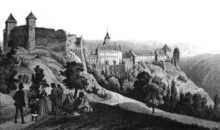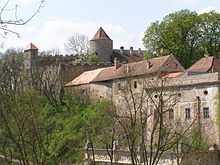Veveří Castle
| Veveří Castle | |
|---|---|
|
Native name Czech: Hrad Veveří | |
|
Veveří Castle | |
| Location | Veverská Bítýška |
| Coordinates | 49°15′24″N 16°27′42″E / 49.25667°N 16.46167°ECoordinates: 49°15′24″N 16°27′42″E / 49.25667°N 16.46167°E |
| Built | 1213 - 1222 |
Veveří Castle (Czech: Hrad Veveří, German: Burg Eichhorn) is a castle located some 15 km northwest of Brno, Czech Republic, on the River Svratka.
History

According to legend, the castle Veveří ("squirrel" in Czech) was founded by Přemyslid Duke Conrad of Brno in the middle of the 11th Century, then only as a hunting lodge. Nevertheless, the first credible recorded mention about the castle is from the years 1213 and 1222, when King Přemysl Otakar I used the fortified castle as a prison for rebellious peers. Initially, it was apparently a wooden residence situated near the church of the Assumption of the Virgin Mary west of the present compound. In the 1220s a stone castle on the extremity of the rocky promontory behind a deep moat cut out of the rock started to grow. The so-called keep is the only structure which has remained well-preserved from this oldest building stage.
King Jan of Luxembourg pledged the castle to nobleman Jan of Vartemberk in 1311, but his son, Margrave of Moravia Charles (later Holy Roman Emperor Charles IV), received the property as a debt settlement in 1335. Charles´ younger brother, Margrave Jan Jindřich (John Henry), then took a fancy for Veveří Castle. He was responsible for the building of its rear part with two towers and an outer ward. In the central area around the keep, he developed the main palace, which included a large hall and the Chapel of St. Prokop (later of St. Wenceslaus). The present appearance of the compound is the result of these building activities, giving the castle its basic silhouette of a medieval fortress.
The castle was a military-civic centre around a manor until the Hussite Wars. During the Hussite wars, Emperor Sigismund positioned mercenary forces of his son-in-law, Albrecht of Austria, around the castle, but he later pledged it to local nobleman Petr Kutěj in 1424. The Hussites besieged the castle in vain during the years 1428-1432. During the second half of the 15th century, the castle was rented by Przemyslaus II of Těšín, who decided to reinforce the castle with the construction of surrounding walls. In 1468, King of Hungary and antiking of Bohemia Matthias Corvinus started his occupation of the castle.
At the end of the 15th century, Václav of Ludanice acquired the castle and became the first representative of his noble family which resided here. But his mismanagement of expenses and debts resulted in the family's eventual sale of manor.
Early Modern period
During the years 1531–1537, Jan of Pernštejn and Jan of Lipá stayed at Veveří Castle. In successive years, the castle changed hands quickly.
In 1609, Zikmund von Tiefenbach acquired the castle by marriage. Rudolf von Tiefenbach, an older brother of Zikmund, was a Protestant at that time, yet he remained loyal to the Catholic Emperor (and later converted to Catholicism). On November 8, 1620, at the Battle of White Mountain, he and his regiment sided with the Imperial Army (i.e. against rebellious Bohemian Estates). As a reward for its loyalty to the Catholic emperors Tiefenbach family could keep the castle and adjacent manor even after the majority of Bohemian Protestant nobility was confiscated and expelled into exile.
In 1645, the Swedish Army laid siege to Veveří Castle, but their attack was unsuccessful, as the castle was well guarded and the defenders well armed. In 1653, Maria Eva Alžběta of the Sternberg family (Rudolf of Tiefenbach's dowager) inherited the castle. In 1668, Václav Michal, Count of Althan, bought the castle and resided there from 1668-1670.
At the end of the 17th century, compound belonged to the House of Collalto. Later, when the House of Sinzendorf (1707–1804) replaced this family, an extensive reconstruction was realized, and since that time, the exterior structure of the castle has remained practically unchanged. In 1742, the Prussian Army, having gained entry by the treachery of the castle steward, pillaged the interior of the estate.
At the beginning of the 19th century, an industrial magnate Vilém of Mundy purchased the castle. Although he had earlier arrived in the area as a simple wayfaring traveller, he achieved prominence and wealth after establishing a cloth factory in 1780 and successfully managing his trade. In essence, he worked his way up until he could own Veveří Castle. In 1830 a Swedish émigré, Prince Gustavus Wasa bought the castle and began systematically to build it as the representative seat of his family. This nobleman lived at the estate with his spouse, princess Louisa. Nevertheless, in 1844 he divorced, and the property went to Baron Jiří Šimon Sina. Before he died in 1856, Sina divided his family possessions. His granddaughter Helena obtained Veveří Castle, but at that time she was still a juvenile, so the property was administered by her father. Later, Helena married Prince Gregor Ypsilanti. She kept a pompous and very expensive court. In 1886, Ypsilanti died in Paris. Widow Helena sold the estate, and in 1881, the castle had a new owner, Moritz von Hirsch-Gereuth.
During this period, Moritz von Hirsch-Gereuth had extensive repairs and renovations completed, including a new iron water supply, roofs, and telephone connections to Obora and the manor house in the nearby town of Rosice. But sadly, he pulled down and destroyed the castle chapel, probably because of his Jewish belief.
In 1896 the castle was bought by the English nobleman Maurice Arnold de Forest. During his time as proprietor, Sir Winston Churchill and his wife Lady Clementine spent several days in Veveří Castle during their honeymoon journey throughout Europe (1908). Churchill alone stayed there already twice before.
After WWI

The de Forest family resided at Veveří Castle until 1925 when they sold it to the newly created Czechoslovak Republic (which included also territory of Moravia). During World War II, the castle was occupied by the Wehrmacht (Germans set up barracks), and during this period area was extensively damaged, including shooting damage to the second floor of the so-called palace. After 1945, a permanent exposition was set up on the site. Although never refurbished to pre-war quality, the castle was still open to the public. In the 1950s, the castle was closed to the public and a school of forestry took over, doing additional damage. Starting in 1972, there was a disastrous project to turn the castle into an international conference center, which fortunately was only partly realized and stopped before more damage to the castl'e historical and artistic value could be done. After the political changes in 1989 the castle continued being neglected.
In 1994, Veveří Castle was again opened to the public, but in 1999, it was abruptly closed and allowed to fall into a state of disrepair during lengthy "property transfers". After several unsuccessful attempts to rent the castle for commercial use, the castle passed in September 1999 from the management of the Ministry of Education under the jurisdiction of the Ministry of Culture and joined the portfolio of historic buildings managed by the National Heritage Institute in Brno. Thanks to the program to protect the architectural heritage of the Ministry of Culture and extraordinary subsidies from the state budget of the city of Brno, the South Moravian Region, and voluntary collections, the worst emergency conditions were stabilized and a number of noteworthy renovations and reconstructions carried out, primarily of the palace. These renovations included a large-scale rebuilding of the "loft" above the palace, and the great dining room with its notable frescoes. Since 2002, the castle is again open to the public, including guided tours of the palace. The complete restoration of all buildings, furniture, courtyards and parks will take many years.
Description of the castle
The castle is usually entered via the so-called Southern Gate (Czech: jižní brána). This originally Gothic gate was recuilt in the late Renaissance style in 1626. Above the portals, there are coats of arms belonging to Zigmund of Tiefenbach and his two wives, Kateřina of Lomnice and Bohunka of Žerotin.
Leading from the Southern Gate to the palace is the castle bridge, mentioned as one of the first ferro-concrete structures in the former Austro-Hungarian Empire. It was built on the site of a gothic drawbridge and later a Baroque bridge decorated with the statues of four saints in 1896.
From the bridge one proceeds through a passage through the palace with keep. On the left is the so-called Black Kitchen, recently restored, where several ovens and a dish-washing basin have been preserved. The keep around which the palace is built is the tallest and oldest of the ten currently visible towers of Veveří Castle, built in the early 13th century as the primary deense element of the oldest building stage of the castle. The palace is the main residential castle building, created by connecting the keep and two medieval palaces.
The former Gothic chapel of St. Prokopius in the palace, which originally extended vertically from the ground floor to the second, was replaced in the late 19th century with separate spaces on the ground floor and a library and administrative spaces on the second floor. A preliminary plan has been developed for the reconstruction of the chapel.
Beyond the palace one proceeds through a courtyard, which was created in the early 19th century by pulling down two 13th-century royal palaces. Luckily, records remain of the appearance of these palaces. Beyond the courtyard lies the so-called English Wing, constructed in the second half of the 17th centiry in the corridor between the Gothic calls. The ground floor served to park horse carriages, while the first floor was used as an armory and later as a granary. The building stands in need of extensive and costly renovation. Yet further along is found the so-called Backyard Palace, erected in the 17th century with two valuted rooms, one above the other. The renovation plans call for it to made into a space for cultural events.
At the southeastern conrner of the castle stands the so-called Eastern Prismatic Tower, built in the 14th century to protect the castle area from the east. South of this tower archaeological remains have been uncovered of walls of a medieval Eastern Castle Palace, which probably dates from the late 15th century and was pulled down before the mid-17th century.
Further reading
- Castle Veveri-Eichorn, Vol. I, Brno, ITEM 2005, ISBN 8O-9O2297-7-8 /Jiří Procházka/
External links
- (Czech) Hrad Veveří
- (Czech) Official site